While Halong Bay’s serene beauty is perfect for relaxing getaways, it’s also a haven for Halong Bay climbing enthusiasts. Thousands of limestone karsts hanging over turquoise waters create a dreamlike playground for rock climbers of all levels, making it a must-visit destination for those seeking adventure. Keep reading to uncover everything you need to know for an unforgettable Halong Bay climbing experience.
Rock Climbing in Halong Bay
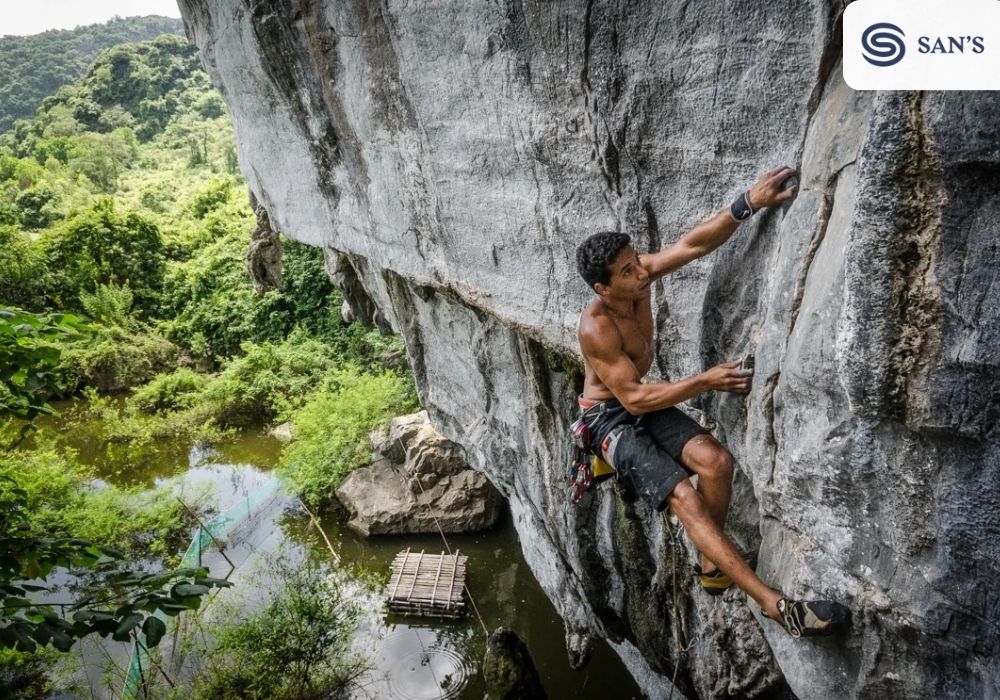
In recent years, the tourism industry in Halong Bay has experienced significant growth, leading to the development of enhanced climbing tour packages. While opting for a tour operator to organize your trip is the safest approach, there is also the option of embarking on a spontaneous island-hopping adventure. With an abundance of limestone islands, caves, lush jungles, and serene lagoons, Halong Bay provides ample opportunities to satisfy your adrenaline cravings.
Among the most popular activities in Halong Bay are rock climbing and deep-water soloing (DWS). There are over 100 climbing routes spread across 10 different cliffs, offering a range of difficulty levels from 4a to 8a+. For DWS enthusiasts, there are 230 lines on 24 cliffs, with grades spanning from 4a to 7c+. If you prefer a quieter climbing experience, it’s advisable to opt for the less crowded Lan Ha Bay, which includes Cat Ba Island. This serene area is devoid of large tourist crowds and noisy boats, making it the perfect destination for an intimate connection with nature.
Ideal Timing for Rock Climbing in Halong Bay
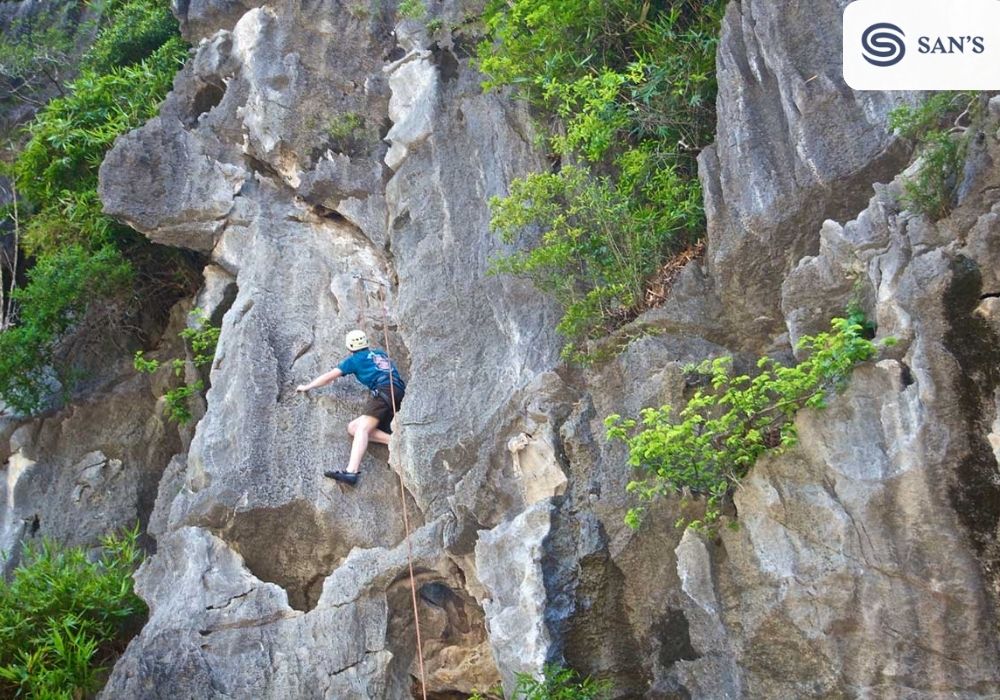
The optimal months for mountain climbing in Halong Bay are May, June, September, October, November, and December. During this period, the weather is pleasant with dry conditions, clear skies, and agreeable temperatures. While there may be occasional chilliness and early morning or afternoon fog, these months are still suitable for climbing.
From July to August, Halong Bay experiences its rainy and stormy season. However, this doesn’t mean your adventure needs to come to a halt. While waiting for storms to pass, you can explore nearby attractions. Some cliffs remain climbable even in adverse weather conditions. Halong Bay enjoys relatively low rainfall compared to other regions of Vietnam, allowing for year-round hiking. This activity is often paired with kayaking to further explore the bay, passing through archways, caves, and floating villages before ascending the mountains for panoramic views.
Engaging in additional activities such as sunbathing, sightseeing, and swimming can help alleviate any initial apprehension or discomfort. Standing atop the high cliffs and taking in the serene and picturesque views of Ha Long Bay serves as a triumphant reward for your adventurous spirit.
Immersing yourself in the sea breeze and the ocean offers a rejuvenating experience that awakens all your senses. With each adventure, you not only get to explore the remarkable Halong Bay and Cat Ba Island but also uncover hidden aspects of your own soul.
What to Prepare for Climbing in Halong Bay
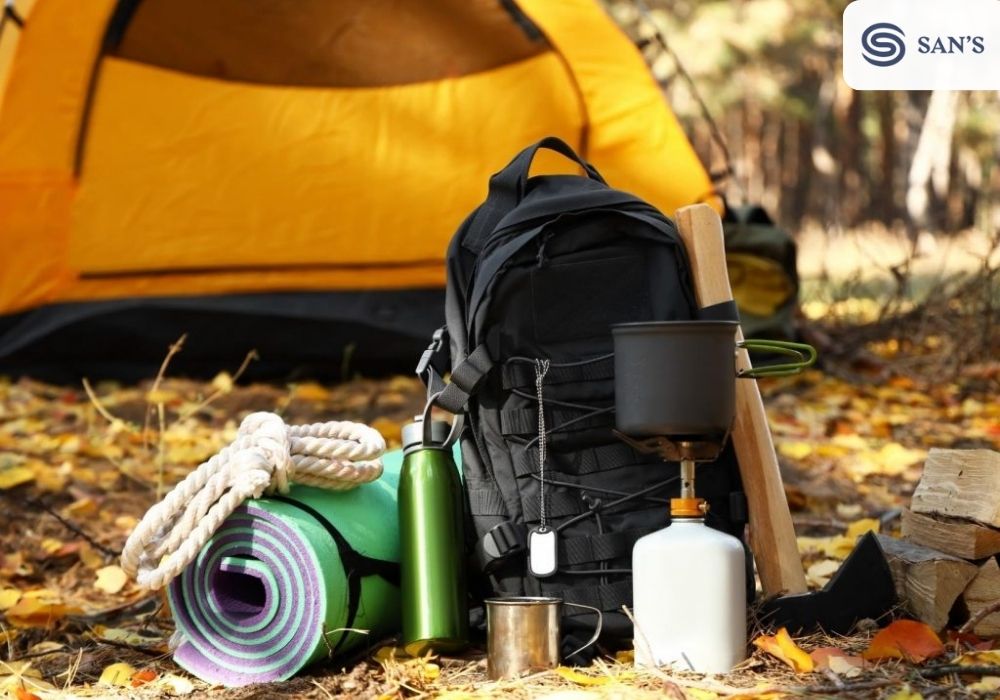
What to bring for your climb depends on your level of experience and skill. Expert hikers might only require sturdy shoes. However, if you’re not well-versed in climbing, ensure you’re in good physical condition, as the cliffs in Halong Bay pose a greater challenge than most. It’s recommended to equip yourself with safety gear, whether you bring your own or choose to rent. This equipment includes specialized climbing shoes, belts, ropes, helmets, and hooks.
>>> You may like: Kayaking in Halong Bay
Best Places for Halong Bay Climbing
Halong Bay boasts numerous securely bolted crags offering diverse climbing experiences on limestone. The most prominent area for rock climbing is Cat Ba Island, the most extensive in its complexity. Climbing in Cat Ba is particularly adventurous at locations like Butterfly Valley, Buddha Cave, Hidden Valley, Ben Beo Harbour, and Deep Water Solo. These spots are conveniently reachable by scooter, which you can rent from your hotel. Here are some of the top 4 rock climbing destinations in Halong Bay.
Hidden Valley
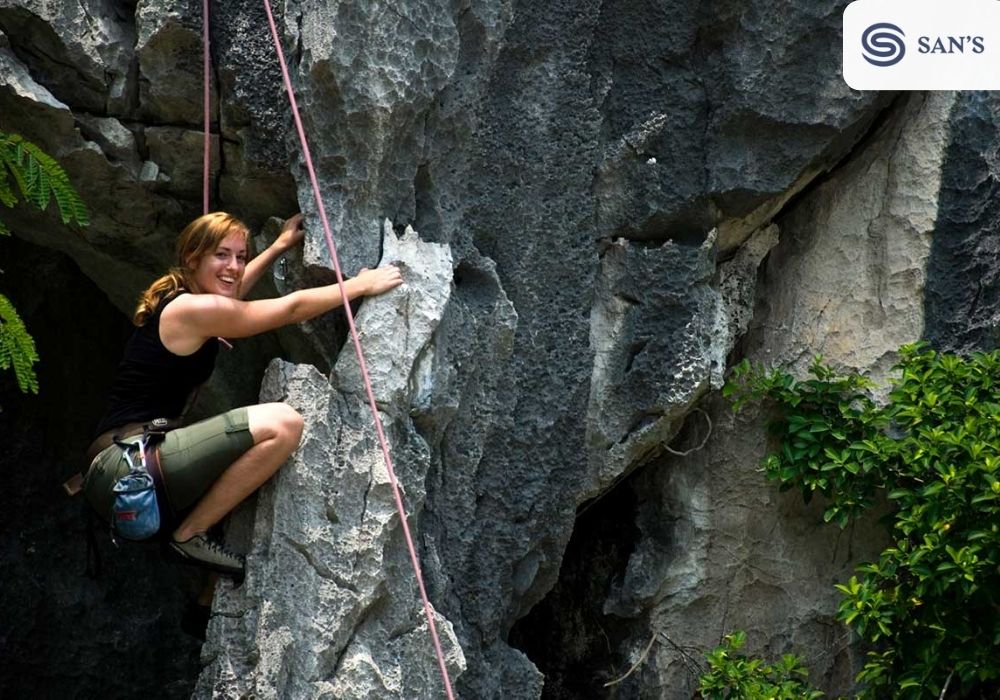
It stands as the second-largest crag for climbing in Cat Ba. Offering a variety of climbing terrains from vertical to considerably steep, it caters to both novice and seasoned climbers. To embark on a climb here, secure an access pass from the climbing stores on Cat Ba Island. Don’t forget to pack insect repellent, as Hidden Valley tends to have many mosquitoes, particularly after rainfall.
Butterfly Valley
Butterfly Valley stands as the most expansive and frequented crag in Cat Ba, situated about 35 minutes away from Cat Ba town via scooter. Nestled amidst local farms and verdant mountains, it offers a serene getaway from urban hustle and bustle. The rock quality here is pristine, offering limestone climbing with abundant pockets and cracks for holds. Climbing in Butterfly Valley is most magical in the summer, when butterflies are aplenty.
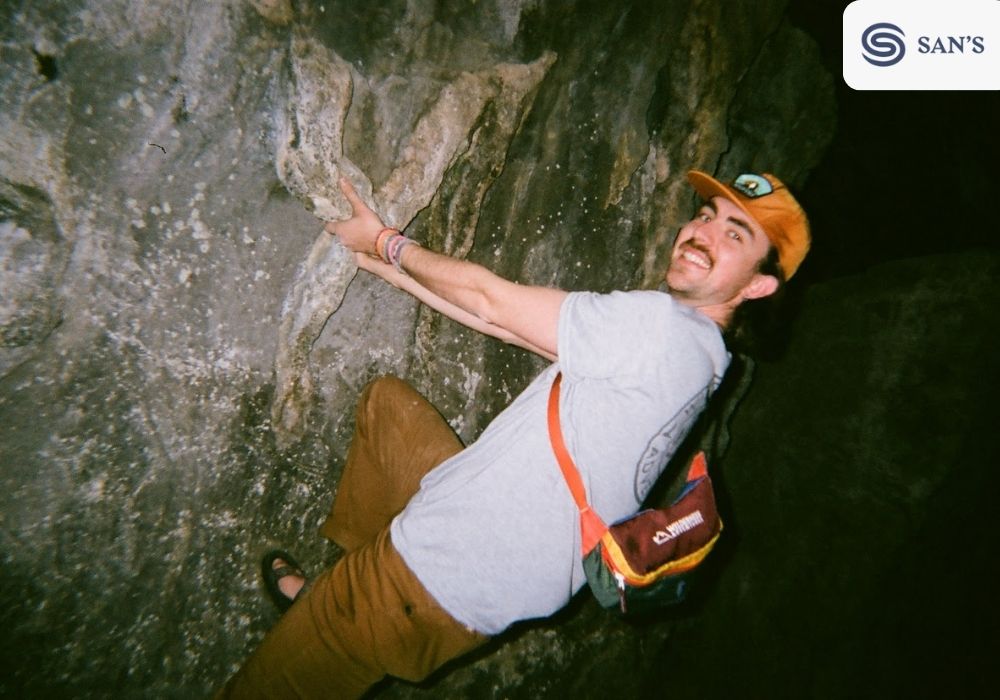
Ben Beo Harbour
Yet another climbing spot in Halong Bay features a stunning limestone facade with a robust overhang towards the peak. The rock has a polished finish, and it provides a panoramic view of Ben Beo harbor, making it a picturesque spot. Local residents might pause to watch you during your climb. The area basks in sunlight during the mornings and becomes shaded by late morning. Do note that after heavy rainfall, the spot requires some time to dry out.
The Cave
The Cave is a compact crag, allowing you to explore most of its routes within a day. It’s an ideal spot for rainy days since the routes are shielded from the elements. Climbing at The Cave requires a fee of 0.5 USD to the landowner, who will then guide you to the climbing area. Inside the cave, there’s a space dedicated to Buddhist meditation. Kindly be respectful and ensure you climb only in the specified zones.
>>> You may also like: Must-visit caves in Halong Bay
Rock Climbing Tips & Experiences
Here’s a checklist of essential gear for your Halong Bay climbing adventure:
- Travel Insurance: Always secure travel insurance for your Vietnam trip. Ensure it encompasses adventurous undertakings like rock climbing.
- Vietnam Climbing Guidebook: Familiarize yourself with the Vietnam Climbing guidebook ahead of your climb. It’s filled with valuable tips and instructions.
- Bug Repellent: Due to the prevalence of mosquito-borne diseases in SE Asia, especially on Cat Ba island (Dengue Fever, for instance), always have bug repellent on hand.
- 60m Rope: Opt for a robust rope equipped with double-dry technology, suitable for the salty and tropical conditions of Cat Ba. A 60m length suffices as Cat Ba routes don’t exceed this.
- Belay Device: Carry a GriGri 2 belay device or another sport climbing-specific tool since Cat Ba’s routes are exclusively single-pitch sport climbs.
- Helmet: Given that some rocks in Cat Ba can be unstable and covered in debris, it’s wise to wear a helmet to protect against potential rockfalls. Ensure it’s adjustable and comfortable for diverse head shapes.
Halong Bay offers more than just rock climbing. For those interested in other outdoor adventures such as snorkeling and kayaking, it’s an excellent destination to explore the best things to do in Halong Bay . Ascending to the summit and witnessing a panoramic view of the Halong Bay complex is truly breathtaking. Although it demands some effort, the view is well worth it. Consider adding a Halong Bay climbing tour to your upcoming Vietnam itinerary to experience this majestic beauty firsthand.
San Travel has provided you with in-depth insights about the overview of climbing activities in Ha Long Bay when you visit here. If you need further assistance, please contact us via email info@santravel.vn or hotline +84 91 297 22 22 for advice!
>>> You may also like: Scuba Diving in Halong Bay
FAQs
- What is Halong Bay Climbing?
- Halong Bay Climbing refers to the activity of scaling the limestone karsts and cliffs found in Halong Bay, Vietnam, offering climbers breathtaking panoramic views of the bay and its surroundings.
- Is Halong Bay suitable for beginner climbers?
- Yes, Halong Bay offers a range of climbing routes catering to all skill levels, from beginners to experienced climbers.
- What is the best time of the year to climb in Halong Bay?
- The ideal times to climb in Halong Bay are during the spring and autumn seasons, avoiding the tropical monsoons and peak tourist seasons.
- Do I need to bring my own climbing gear?
- While it’s recommended to bring your own specialized gear, several local operators in Halong Bay offer gear rentals and climbing packages.
- Is it safe to climb in Halong Bay?
- Yes, with the right equipment and precautions, climbing in Halong Bay is safe. However, it’s always advisable to climb with a guide or a local operator, especially if you’re unfamiliar with the area.
- Are there guided climbing tours available?
- Yes, several local operators offer guided climbing tours that include equipment, instruction, and safety measures.
- How can I respect the environment while climbing in Halong Bay?
- Climbers are encouraged to practice “Leave No Trace” principles, avoid disturbing local wildlife, and ensure that they do not leave behind waste or harm the natural formations.
- Can I combine my climbing adventure with other activities in Halong Bay?
- Absolutely! Many visitors combine climbing with kayaking, boat tours, and visits to local caves and grottos.
- Are there any age restrictions for climbers?
- While there’s no strict age limit, it’s essential for climbers to be in good health. Some tour operators might have specific age guidelines, so it’s recommended to check in advance.
>>> Discover more fun activities in Ha Long Bay. Follow us on Instagram today!


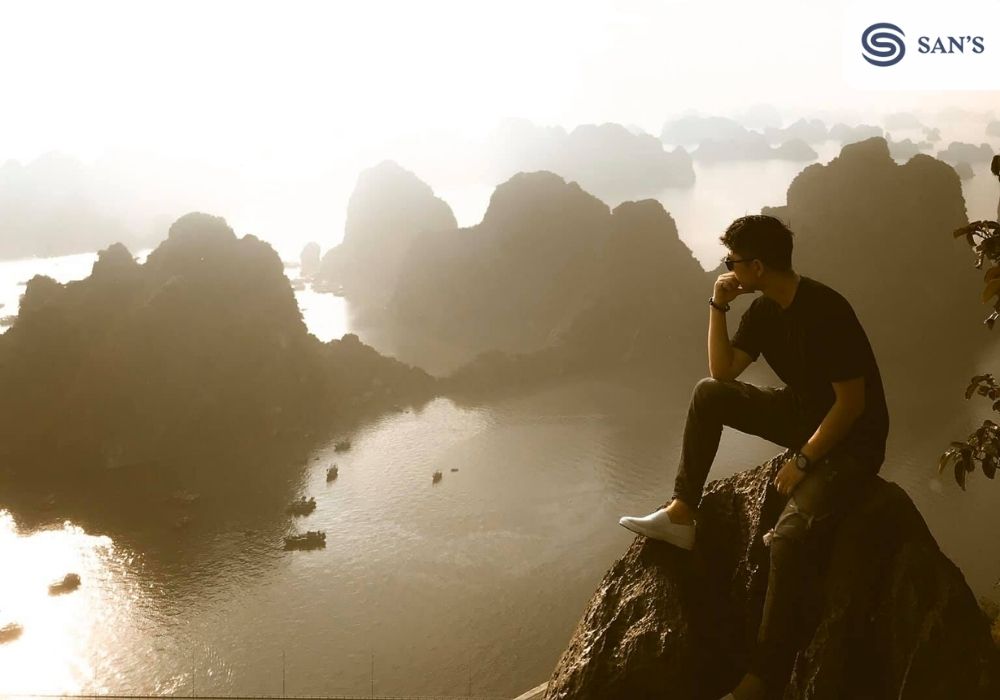
Comment (0)